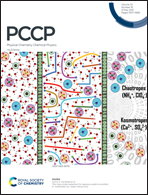Design of highly efficient g-C3N4-based metal monoatom catalysts by two extra-NM1 atoms: density functional theory simulations†
Abstract
Graphitic carbon nitride (g-C3N4) is recognized as a favorable substrate for monoatom catalysts due to its uniform nanoholes for anchoring metal monoatoms, while the oxygen evolution reaction (OER) overpotential (ηOER) values of g-C3N4-based metal monoatom catalysts are still large. To reduce the ηOER values, a class of novel TM1NM1NM1/g-C3N4 was designed via density functional theory simulations, where TM1 = Fe1, Co1 or Ni1 and NM1 = C1, N1 or O1. Contributing by two extra-NM1 atoms, the OER catalytic activities of these materials were effectively improved owing to the shortened TM1–NM bonds and weakened chemical activity of TM1 atoms. Based on the volcano activity relationship between the theoretical overpotential (ηOER) and d band center of the TM1 atom (εd), the chemical activity of TM1 atoms needs to be adjusted to a suitable magnitude (εd near −4.883 eV) for a good catalytic activity. The designed Fe1C1O1/g-C3N4 with the εd of −4.893 eV exhibited an excellent OER catalytic activity of ηOER = 0.219 V. This strategy was applied to devise the reaction active sites and highly efficient catalysts by adjusting the chemical activity of the TM1 atom with suitable extra-NM1 atoms.



 Please wait while we load your content...
Please wait while we load your content...